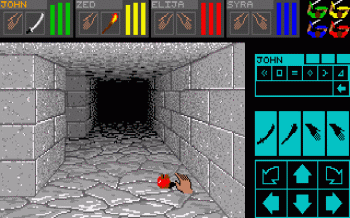Faux First-Person 3D
A common technical solution in early Adventure Games and Role Playing Games from the late 1980s and the early 1990s, before Polygonal Graphics were advanced enough to do this properly.
As the player characters wander through a dungeon or walk along the city streets, the player sees the corridors in a first-person perspective. However, the view isn't truly rendered in 3D. Rather, it is composed of multiple algorithmically assembled 2D building blocks; to render the view, the game appropriately arranges these images on top of pictures that depict the floor and ceiling. Sometimes, enemies and items present are overlaid as sprites. Early on, the walls were black-and-white wireframe, or filled with a uniform color.
This differs from games where each individual view is basically a single image, like the first Myst, or games that have each node as a single panorama, like the third Myst or Google Maps Street View.
In games that use this, the player moves from cubic node to cubic node of an Invisible Grid. All walls are orthogonal while all ceilings and floors are the same level.
Compare First-Person Shooter.
- The Bard's Tale (1985)
- Scarab of Ra (1987)
- The Gold Box games, as well as those created with Unlimited Adventures.
- And Dungeon Craft, UA's modern remake.
- The Eye of the Beholder series
- Dungeon Master
- The browser game series Coffee Quest.
- Swords & Serpents
- Megami Tensei, Megami Tensei II, and the first Shin Megami Tensei I game.
- Day of the Viper, a first-person Roguelike which is most emphatically not related to Battlestar Galactica despite the misleading cover.
- The original Phantasy Star I.
- Sword of Vermillion
- Shining in the Darkness
- And the sequel Shining the Holy Ark.
- Arcana
- The main Might and Magic series up to and including World of Xeen.
- The main Wizardry series up to and including Crusaders of the Dark Savant.
- Early Ultima games:
- Ultima I and Ultima II use wireframe black-and-white graphics. II upgraded the monsters to blocky pixel art.
- Ultima III and Ultima IV fill the walls with uniform color, and dispensed with visible wandering monsters.
- Ultima V added some detail to the walls and floors, and brought back visible in-dungeon monsters (at rather higher quality than in I and II).
- Particularly advanced examples were the early CyberFlix DreamFactory games, like Lunicus and Jump Raven. They looked like flat-shaded 3D, but were in fact prerendered images and animations turned into 2D vector art. This allowed the appearance of realtime travel and rotation through 3D environments.
- Buildings in The Addams Family: Fester's Quest.
- Maze War, the original First-Person Shooter.
- Escape From the Mindmaster
- Stonekeep used pre-rendered backgrounds to animate each step the party makes, even resizing and re-angling enemy live-action sprites.
- The Lone Ranger, Golgo 13, Goonies II, and Friday the 13 th on the NES all had segments like this.
- Xybots had Faux Third Person 3D view.
- Realmz originally just had an overhead automap that controlled like this for indoor areas, but an optional 3D feature was added in 4.0. The twist? Scenarios were then updated so that some dungeons permeated with especially sinister magic would disable the overhead view unless you cast a certain spell.
- The first Toy Story game for the Sega Genesis and SNES had a level inside the Claw Machine (called "REALLY Inside the Claw Machine") which was basically this. The only 3D elements were the Little Green Men, which you had to rescue, and Woody's arms.
- Most Driving Games until the 32-bit era. Many were simply an endlessly repeating grey strip with a car sprite on it, surrounded by layered 2D buildings/cliffs/bridges/whatever.
- The Black Onyx
- Advanced Dungeons & Dragons: Treasure of Tarmin
- Legend of Grimrock: Is a modern revival of this fashion of gameplay, since few exist.
